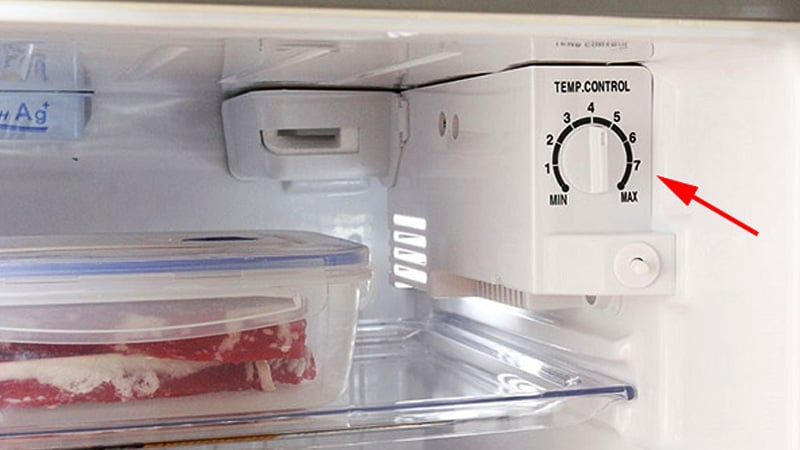
A Small Button on Your Refrigerator Can Save You Millions on Electricity: Many People Don’t Know This
Few people realize that there is a small button inside a refrigerator that, if adjusted correctly during the winter, can help save a significant amount on electricity bills. Today, refrigerators have become an indispensable appliance in almost every household. They operate continuously 24/7, both in summer and winter, keeping food fresh for longer periods. However, because they run non-stop, refrigerators are also among the household appliances that consume the most electricity. Surprisingly, many users are unaware that simply adjusting a small control inside the fridge during the colder months can reduce electricity consumption considerably.
How Should You Adjust Your Refrigerator in Winter to Save Electricity?
Statistics from Vietnam Electricity (EVN) in May show that a large refrigerator consumes an average of 50–75 kWh per month, ranking third among household appliances, after electric stoves and water heaters.
In reality, these figures represent only an average. User habits can play a crucial role in reducing the energy a refrigerator consumes. Particularly in winter, a simple adjustment in the two main compartments—the fridge and the freezer—can make a noticeable difference. Yet, many users are unaware of this simple but effective step: adjusting the temperature using the control knob or digital panel. With this small adjustment, families can lower their electricity bills significantly.
Expert Advice on Winter Refrigerator Settings

Electrical experts recommend that during winter, users can save electricity by lowering the cooling level of their refrigerator. Modern refrigerators often have temperature settings ranging from 1–5 or 1–6. In the summer, the setting is usually at maximum or near maximum to keep food cold, but in winter, adjusting the setting to 2–3, or even 1, is often sufficient.
At level 1, the refrigerator’s internal temperature typically ranges from 2–5°C, which is ideal for maintaining food freshness while consuming less electricity. This principle applies to the freezer compartment as well.
In addition, users can adjust the temperature based on the amount of food stored. For instance, if the fridge is not fully stocked, a lower cooling setting is sufficient. Conversely, when storing large quantities of food, a higher cooling level may be necessary. For freezers containing fresh seafood or other perishable items, maintaining a high cooling level around -18°C is recommended to prevent bacterial growth and keep food safe and fresh for longer.
Tips to Further Save Electricity with Your Refrigerator
Beyond adjusting the temperature, experts suggest several practical habits to reduce electricity consumption:
1. Position the Refrigerator Properly
Heat escapes from the back or sides of a fridge. Blocking these areas with walls or other objects can reduce heat dissipation, forcing the appliance to work harder and consume more electricity. Avoid placing the refrigerator near other heat-generating devices, such as microwaves, ovens, or stoves, to prevent unnecessary energy use and extend the appliance’s lifespan.
2. Limit Prolonged Door Opening
Keeping the fridge door open for too long causes cold air to escape, making the compressor work harder to maintain the internal temperature. This not only increases electricity consumption but can also reduce the efficiency of food preservation.
3. Store Food in Glass or Ceramic Containers
Experts recommend using glass or ceramic containers to store food. These materials retain cold air more effectively. Organizing containers properly, without overcrowding or stacking them haphazardly, allows air to circulate evenly and reduces energy usage.
4. Regular Cleaning and Maintenance
Although it may seem simple, regularly cleaning your refrigerator is essential. Dust and dirt can accumulate in the air vents, making the compressor work harder and consume more energy. Experts suggest cleaning the fridge every 1–3 months to maintain optimal performance and energy efficiency.
By following these tips—adjusting the temperature according to the season, organizing food properly, and maintaining the appliance—households can significantly reduce electricity consumption while keeping food fresh and safe. What may seem like a tiny adjustment can translate into substantial savings over time.
News in the same category


Don’t Throw Away Your Used Balm Jar – Here’s a Super Useful Way to Reuse It That Every Family Needs

Why Do Flat Electrical Plugs Have Two Round Holes? The Hidden Purpose Is Brilliant

The Little Aluminum Ring on a Sausage Stick Has a Hidden Use — Few People Know Its Clever Purpose

Don’t Eat Tofu Right After Buying It — Freeze It First for a Magical Effect: You’ll Wish You Knew This Sooner

Pour This Liquid Into the Drain – The Unpleasant Odor in Your Bathroom Will Quickly Disappear

Get Rid of Termites in Wooden Doors Easily – Keep Your Wood Beautiful for 10 Years

What you see reveals your personality

You’re doing it all wrong. Here’s the right way to store knives

You’re doing it all wrong. Here’s the right way to unclog your drain

10 cooking cleanup habits you’re doing wrong

Genius!

Need some assistance here

Tips for choosing clean, natural vegetables without worrying about harmful chemicals

3 benefits of putting lemon sprinkled with salt in the room, the last one many women like

Experience in growing tomatoes in pots with lots of fruit, plant one plant and eat all year round, no need to buy

After boiling the chicken, do this step: The chicken will have golden brown, crispy skin, and will be delicious to eat.

Want to eat ripe jackfruit, don't 'absorb' chemicals, go to the market and choose this way
News Post

Vertical Nail Ridges? Here’s What Causes Them — and How to Fix It

The Unseen Heroes: A Rescue Dog's Loyalty That Saved My Life

Barrett’s Miracle: A Journey of Faith, Strength, and Prayer

A Farewell to a Friend and His Passion for Music

Top 5 Nutrients to Reduce Swelling in Feet and Legs

A Rare Encounter: The Moment a Mountain Lion Meets a Baby

Stray Cats Bring a Bitcoin Mine to a Standstill — And Melt Hearts in the Process

If you sleep with socks on, see what happens

Each Tooth Is Connected to an Organ in the Body – How Tooth Pain May Reveal Hidden Health Problems

Dominika’s Fight for a Childhood Without Pain

Why There's A Growing Trend Of Straight Men Dating Trans Women

Michalinka’s Fight for Life: A Tiny Body, a Giant Spirit

A Miracle in the Making: Baby Harlan’s Fight for Life

From Tragedy to Triumph: The Unbreakable Spirit of Janey Carter

A Battle of the Wild: The Confrontation Between a Raging Elephant and a Baby Hippo

7 Heart-Healing Foods Your Cardiologist Won’t Tell You About

Never Clean Your Light Switch with Water: Here’s a Trick to Make It Spotless

Bad Habits After Doing Laundry That Can Make Your Whole Family Sick! Many People Overlook This Detail
